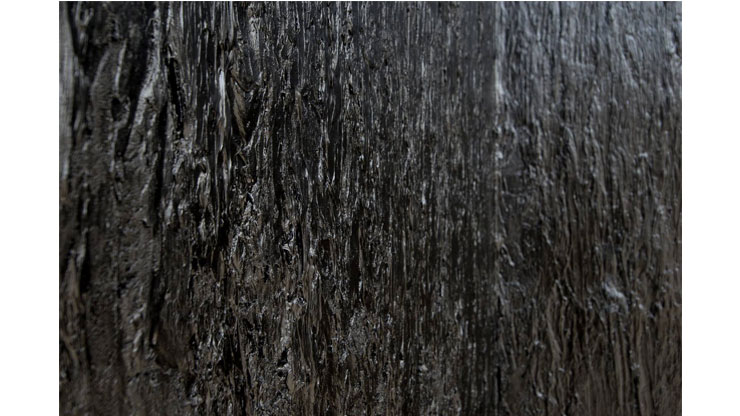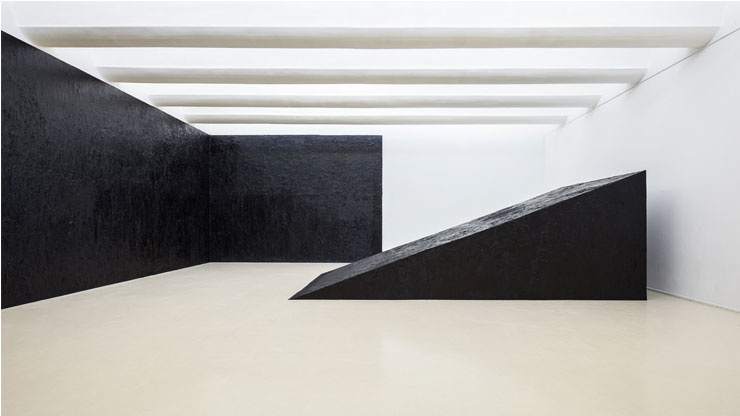Orly Sever | Wall Run
Rich, dense, black materiality is typical of Orly Sever’s sculptural installations, which have been on view at the Herzliya Museum of Contemporary Art (2005), Haifa Museum of Art (2008), and Tel Aviv Museum of Art (2015). Her work opens up a mentalscape encoded in matter; it offers an abstracted, pithy move presented through signs of the creative body’s action, and its material expression is both enticing and repulsive. A persistent ritual act leaves in the material charged traces that combine fear, pain, threat, and desperation as well as defiance and the prospect of lift-off, in opposition to submissive acceptance and in refusal of head bowing.

While working on the exhibition, the newspapers reported that artists were protesting Anish Kapoor’s exclusive rights to a new black substance developed by scientists at Surrey NanoSystems, which absorbs 99.96% of all light.[1] Black has been at the center of artistic exploration through the ages, gradually changing its status from an accompanying shade (used for shading and to create a sense of volume) into a central element. In the process, it has accrued layers upon layers of cultural, ideological, social, and ecological connotations. Black’s absorption of light is a continuous action, incessantly turning the blackened object into everything and nothing. In Sever’s current installation, black has a strong material presence, too: the black tar she uses soils, emits a strong smell, stains. This sticky, unsettling substance is smeared on the walls as well as on an object at the center of the space – an object which may be seen as a bunker or bomb shelter, a grave, or a lift-off surface.
The black tar used by Sever is a product of crude oil, an organic material created underground through long transformative processes. But it is experienced as an ecological hazard, environmental pollution in dissonance with our ideal image of nature. The image of the cormorant covered in black oil during the First Gulf War, in 1991, became a symbol of the destructiveness of a war machine which combines security interests and the powerful capitalist interests of the oil industry.[2] Sever’s installation also connotes the material’s easily combustible nature, like a ticking bomb.
However, while raising all these associations Sever’s installation also speaks the abstract language of modernism and engages with the discourse of performative action in exhibition spaces.[3] In doing so, it also engages with the history of art – a dialogue directed at the very heart of museological discourse. The walls of the “white cube” are blackened, counteracting the elegant, restrained, civilized rationality manifested by the brightly lit white museum space.
In the years following World War II, while Abstract Expressionism was becoming prevalent in the United States, its European equivalent was the French Art Informel (“Unformed” Art).[4] This style was informed by monochromes (particularly black, gray, dirty white, and brown), strong gestures, such as paint smearing using a spatula and dark, paint-laden impastos. Within this wide artistic tendency some artists channeled abstraction toward the melancholy sentiments expressed by the Lyrical Abstract. In this context, abstraction may also be seen as comforting blindness which obscured the horrors of the World War, which had shaken up the cultural foundations of Europe, and avoidance of direct confrontation. Another group of Informalist artists, which included Pierre Soulage, Jean Dubuffet and others, produced brutally direct, piercingly depressing paintings. In light of the atrocities of the World War, these artists proposed anti-aesthetical revolutionary expressions of protest as opposed to degenerative cultural finesse and paralyzing bourgeois comfort. These works were informed by raw materiality and direct application of paint. They avoided overworking the painted forms and figurative imagery, giving expression to a search for authenticity and primary values alongside pain, loss, danger, and vulnerability. In Israel, there were two such artists (both part of the New Horizons group), to whose work Sever’s later installations are affined. Avshalom Okashi (1916-1980) painted a great many abstract, thickly impastoed black monochromes [fig. 1]. Yechiel Shemi (1922-2003) used tar [fig. 2] and black paper in his works. His sculptures, in which iron plates frame structures and geometric arrangements, are an inseparable part of the landscape on Kibbutz Cabri where he lived and worked, which is also the birthplace and current residence of Orly Sever.[5]
In the late 1990s, Yve-Alain Bois and Rosalind Krauss searched – in the exhibition “L’Informe: mode d’emploi” (Formless: A User’s Guide) curated by them at the Pompidou Center in Paris and in the book accompanying it – for a wide definition of abstraction in modern art. To that end, they turned to Georges Bataille’s notion of the “informe” (formless). Bataille, they write, “refuses to define ‘informe’: ‘It is not only an adjective having a given meaning, but a term that serves to bring things down [déclasser] in the world.’ It is not so much a stable motif to which we can refer, a symbolizable theme, a given quality, as it is a term allowing one to operate a declassification, in the double sense of lowering and of taxonomic disorder. Nothing in and of itself, the formless has only an operational existence: it is a performative, like obscene words, the violence of which derives less from semantics than from the very act of their delivery. … The formless is an operation.”[6]
The title of Sever’s current project, Wall Run, implies danger and pain which are the outcome of an extreme, challenging and addictive activity. It is the name of one of the “moves” in Parkour, whose practitioners engage in getting from one point to another while spectacularly overcoming obstacles – relying only on the human body, without protective means – in a variety of ways, including jumps from high places, vaulting over fences, and walking on bare walls. In doing so, they challenge gravitational physics as well as the human instinct to protect one’s body. The desire to stretch boundaries, to overcome the laws of physics and lift off (physically and metaphorically) brings to mind the myth of Icarus – and, of course, his final plummeting to his death. From these perspectives one may interpret the sculptural object installed at the center of Sever’s space as a point of departure both for lifting off and for crashing. Sever’s sculptural installation resonates with the interior of a sealed grave which is, at one and the same time, a site of action imbued with persistent, challenging defiance; its walls are always in the process of being blackened , a site of an ongoing performative operation.
—–
[1] Shany Littman, “Artists Angry at Anish Kapoor for Purchasing the Rights to Blackest Pigment,” Gallery supplement, Haaretz, 1 March 2016 (Hebrew).
[2] See, for instance, Yaron Weisbein, “The Day the Cormorant Died,” Teva Va’Aretz, 33 (September 1991), p. 6 (Hebrew).
[3] See Adrian Henri, Environments and Happenings (London: Thames & Hudson, 1974).
[4] The term was coined by the French art critic Michel Tapié in his book Un art autre (Art of Another Kind), 1952.
[5] An iron sculpture by Yechiel Shemi is installed at the entrance plaza of Beit Yad Labanim adjacent to the Herzliya Museum of Contemporary Art.
[6] Yve-Alain Bois, Rosalind Krauss, Formless: A User’s Guide (New York: Zone Books, 1997), p. 18.

Aditional Exhibitions
-
Zeev Engelmayer | The Daily Postcard
Zeev Engelmayer | The Daily Postcard
-
Be’eri Plant Bed
Hosted Project
Curator: Nivi Lehavi
-
Structures
Weaving in Israel, from Functionalism to Fiber Art Group exhibition
Curator: Dr. Noga Bernstein | Assistant Curator: Aya Armoni
-
Gur Inbar
Yarn of Clay
Curator: Galit Gaon | Assistant curator: Tzafi Sivan Spivak
-
Fatima Abu Roomi
Close to Herself
Curator: Prof. Yael Guilat
-
Siona Shimshi
Textile Patterns in Her Own Hand
Curator: Yuval Etzioni
-
Eternal Spring
Mambush Tapestry Workshop, Ein Hod, 1966–1985
Curator: Zeela Kotler Hadari | Assistant Curator: Yuval Keshet
This is a test-run of the website, thanks for your patience! Your input is welcome. info-museum@herzliya.muni.il </ strong>